Gold and Gems: Uncovering the Glory of Mysore’s Chinnada Simhasana
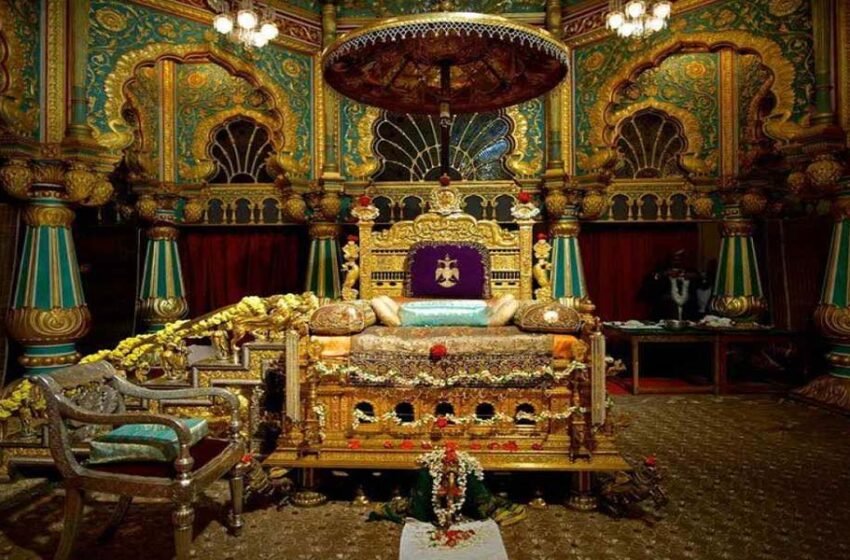
Gold and Gems: Uncovering the Glory of Mysore’s Chinnada Simhasana
Mysore, a city nestled in the southern part of Karnataka, India breathes life into history. This place has witnessed the rise and fall of empires like the Hoysala and The Vijayanagar Empire, along with the fascinating generation of The Wadiyar Dynasty. The iconic Mysore Palace serves as the legitimate residence of this dynasty and the headquarters of the kingdom. The Golden Throne, also known as Chinnada Simhasana, is the royal throne of this kingdom. This incredible throne encapsulates the respect of the kingdom, it’s cultural patronage and the centuries of dynastic rule it has witnessed. It stands as a symbol that goes beyond the realms of royalty.

The history of this throne goes back to The Mahabharata, as it originally belonged to Yudhishthira; the eldest son of The Pandava brothers. After which the throne was passed down to numerous kingdoms and has been appreciated by the rulers. According to numerous sources, in the early 14th century it belonged to the Raya Kings of Kampili and was passed down to the Vijayanagar Empire [1336-1646]. The Wadiyar Dynasty of Mysore then overtook the kingdom and along with it the throne. However, the glory of this throne witnessed a period of decline during the rule of Hyder Ali and Tipu Sultan [ 1761-1769] as it faced degradation in its status and significance. It is said the throne was locked away in one of the rooms of Tipu Sultan’s palace which marked a symbolic diminishing of its regal prominence. Following his death, the fortunes of the golden throne took a turn for the better as it was restored by the Wodeyars [Wadiyar Dynasty], the ruling family of Mysore. The return of the throne to the hands of the family that had cherished it initially marked as a pivotal moment in its history.
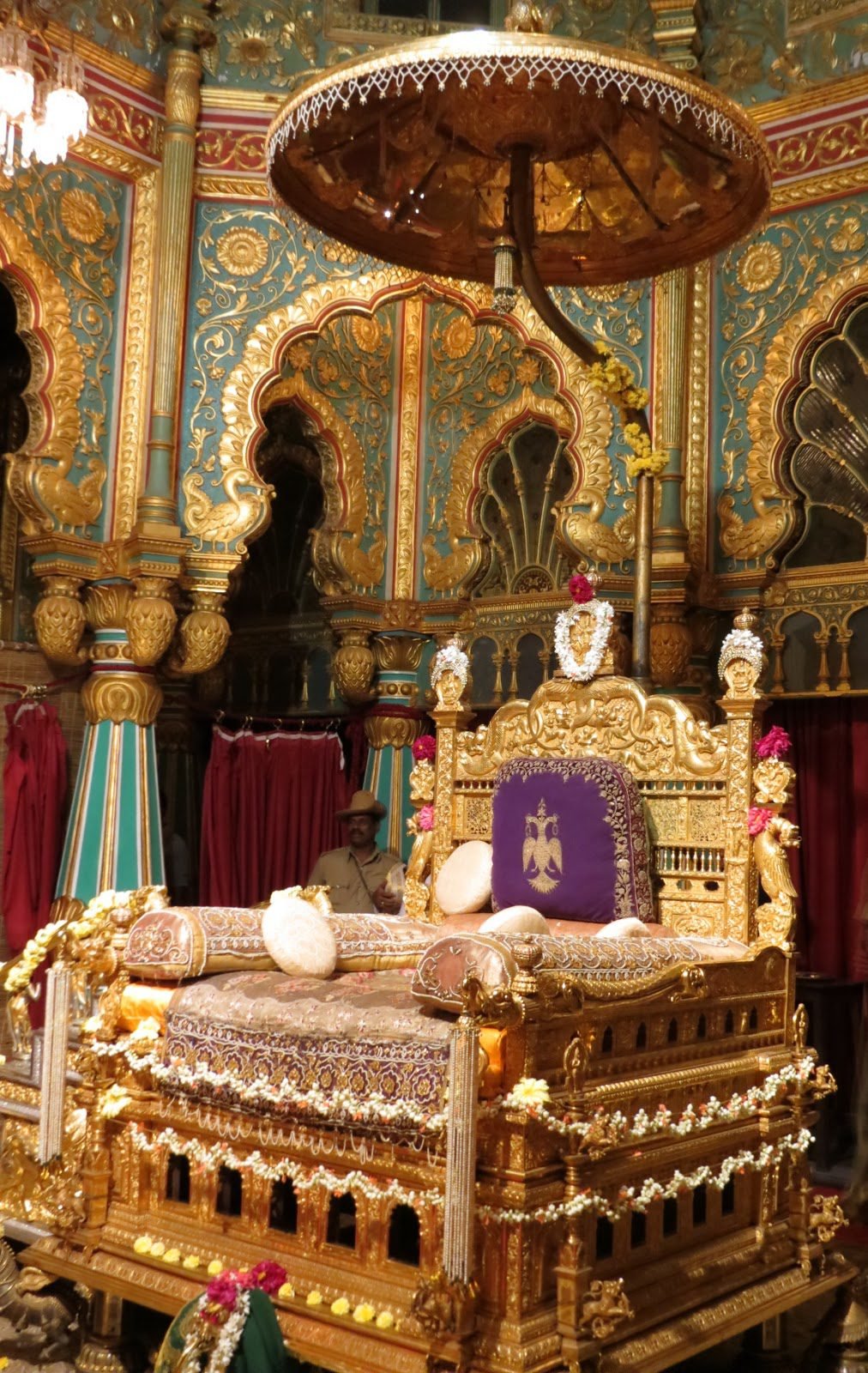
The rich legacy of Wadiyar Dynasty is intricately intertwined with the narrative of the golden throne. This kingdom was first ruled by Yaduraya Wodeyar in the 14th century after which their rule is known for their patronage of art, literature and culture and the Mysorean traditions flourished under them. Their residence, The Mysore Palace was a blend of Indo-Saracenic, Rajput and Gothic architectural styles and the throne served as the seat of their kingdom. This dynasty even faced various challenges and conflicts such as the invasions of Hyder Ali and Tipu Sultan and the conflicts with The British East India Company during the Anglo- Mysore war. Tipu Sultan was defeated in the fourth Anglo-Mysore war and the Wadiyar dynasty was restored to the throne but under the british influence.
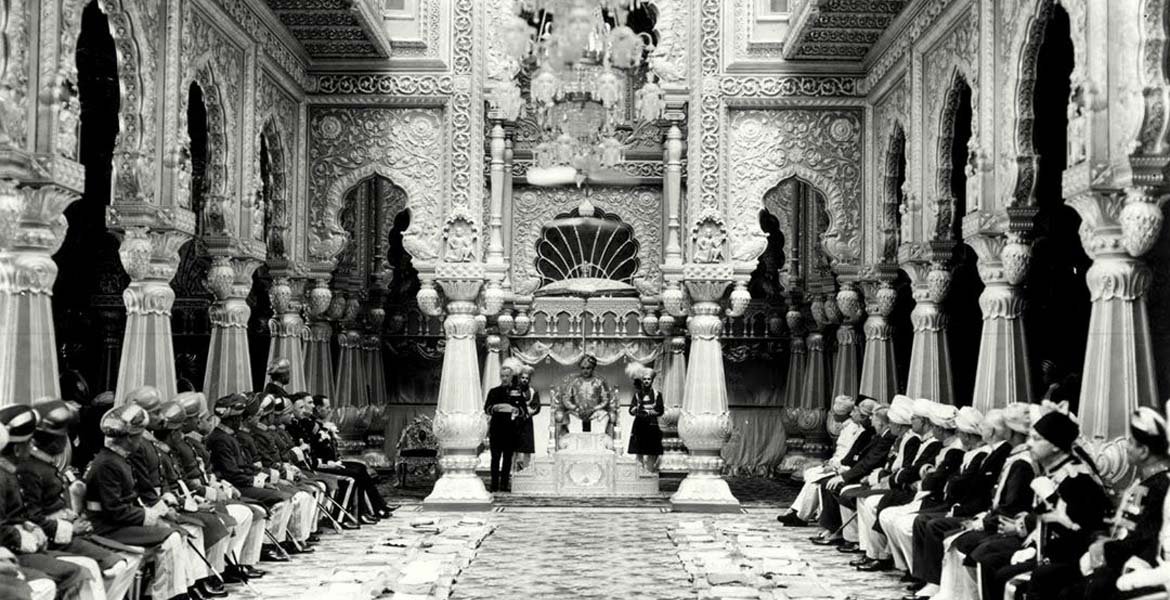
The Golden Throne is the epitome of meticulous craftsmanship and includes symbolic significance that reflects the cultural and historical richness of the region. Its structure includes a main seat, steps leading to the seat and a golden umbrella positioned above the seat. It was carved out of figwood and ivory plaques are used to decorate it. Furthermore, the throne was embellished with jewelry, precious stones, gold and so on by Singannacharya. The steps leading to the seat as mentioned before features female figures known as Salabhanjikeyaru and the four sides of the throne include elephants on the east, horses on the south, the west had soldiers and there were chariots in the north. It is interesting to know the symbolism of these four sides according to Hindu mythology as the east symbolizes strength, wisdom and prosperity, the south is associated with power, speed and victory whereas the motifs of soldiers in the west may symbolize protection, valor and defense as the west is often related with the direction of the sunsets which suggests the need for protection as the darkness prevails.
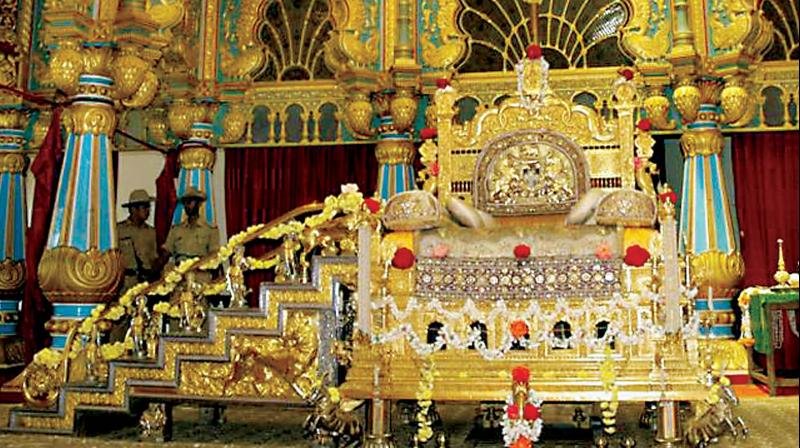
Lastly the chariots are related with the north and it represents progress leadership and sense of purpose. This symbolism aligns the throne with the traditional belief reflecting a deeper layer of cultural and mythological significance. The royal seat is called the Koormasana, a tortoise seat and is surrounded by cushions, pillows and cloths covered with precious stone. There are artistic depictions on the back side of the throne which showcases birds, which represents freedom and spirituality and their inclusion may signify a connection to the divine. Lions, which is a powerful symbol associated with strength, courage and royalty of the ruling dynasty and lastly it includes Flowers, which represents the fleeting nature of existence. Such detailed designs convey deeper meanings that resonates with the values and morals of the society. Moving forward to the center of the backrest, it features Goddess Chamundeshwari, Goddess Laxmi and Goddess Saraswati on either side and are surrounded by the gods of 8 direction [Asta Dipalakas].
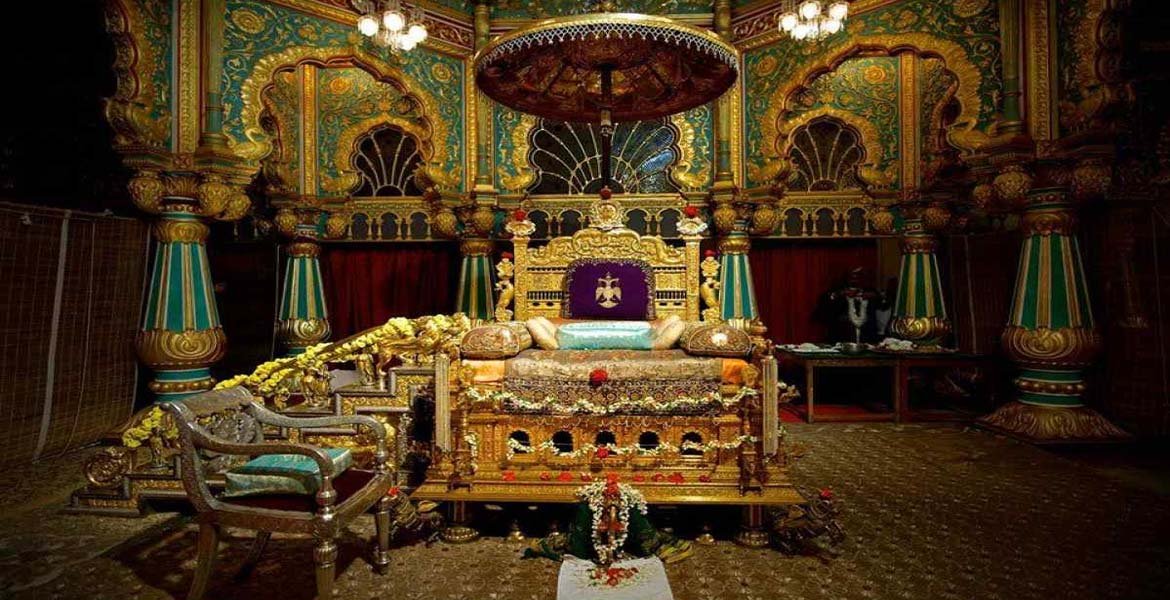 The quotes Satyamevoodharaham which means “I shall uphold the truth always” is displayed on the backrest along with the royal emblem of Mysore kings. Let’s not forget the royal umbrella positioned above the throne. It is 2.25m tall and is studded with gems and precious stone and at the top of it there is a celestial bird called Huma, which looks like a swan and has an emerald gem on its beak. It is believed that the person on which the shadow of the bird falls will wear the crown eventually. Hence, it can be said that this majestic throne is the symbol of regality and cultural heritage and the intricate details enhance not only the artistic powers but also its cultural significance which makes it a historical masterpiece.
The quotes Satyamevoodharaham which means “I shall uphold the truth always” is displayed on the backrest along with the royal emblem of Mysore kings. Let’s not forget the royal umbrella positioned above the throne. It is 2.25m tall and is studded with gems and precious stone and at the top of it there is a celestial bird called Huma, which looks like a swan and has an emerald gem on its beak. It is believed that the person on which the shadow of the bird falls will wear the crown eventually. Hence, it can be said that this majestic throne is the symbol of regality and cultural heritage and the intricate details enhance not only the artistic powers but also its cultural significance which makes it a historical masterpiece.

The city of Mysore is also famous for its grand Dasara celebrations. It is a joyous occasion which is celebrated on the triumph of righteousness. It is believed that Lord Rama defeated Ravana on this particular day. During this festival the Mysore Palace is illuminated and serves as the main venue for the festivities. Interestingly, the golden throne is usually kept in safe vault and is taken out and assembled. It is placed under a glass-topped pavilion and only takes its true regal essence when enhanced with gold lion figures. This transformation emphasizes the royal symbolism and the grandeur of the throne. The gold lion figures elevates the throne to its majestic stature. After this the current successor of the royal family ascends the throne and conducts business or durbars. This festival was bought to Mysore by the Wadiyar Dynasty and the traditions are followed ever since. These celebrations adds an element of mystique and intrigues our interests surrounding the throne’s ceremonial enhancements and the transformation it undergoes. Hence it is not just an object of history anymore but a captivating part of the city’s cultural and historical heritage.

Weaving together the legacy of dynastic power and artistic brilliance, the golden throne lies in the heart of Mysore’s tapestry. Centuries have passed and the throne has served as the royal seat of the Wadiyar’s which showcases their power, authority and continuity of rule. It also represents the dynasty’s support for arts and its heritage. The artisans who were involved in the making of this magnificent throne showcased the epitome of their craft under the royal patronage. It can be proudly said that the throne has withstood the test of time, be it the decline of its glory during the reign of Tipu Sultan or its restoration. Along with that the significance of the throne during Dasara and its presence during the grand procession contributes to the festivals cultural and religious importance. What amuses people is the aesthetic appeal and the intricate carvings on the throne making it a symbol of royalty and regality. Apart from the cultural and traditional perspective, the throne also attracts people from across the world to witness the glory of Mysore and its kings.

The throne is over 800 years old but even now the royal family of Mysore gears up and prepare for their private festivities. The current successor Sri Yaduveer Krishnadatta Chamaraja Wadiyar assembles for the private darbar and the palace priests organizes a symphony of ancient rituals. Ganapathi homa, Chamundeshwari Pooja, Navagraha homa became the sacred keystones that resonates with the Mysore palace. This throne has witnessed a fusion of the timely traditions and the contemporary continuation of a legacy that will eternally remain engraved. After all the festivities the royal throne will be dismantled and kept in a secret vault. However, it is kept for public viewing until the festival of Dusera ends.
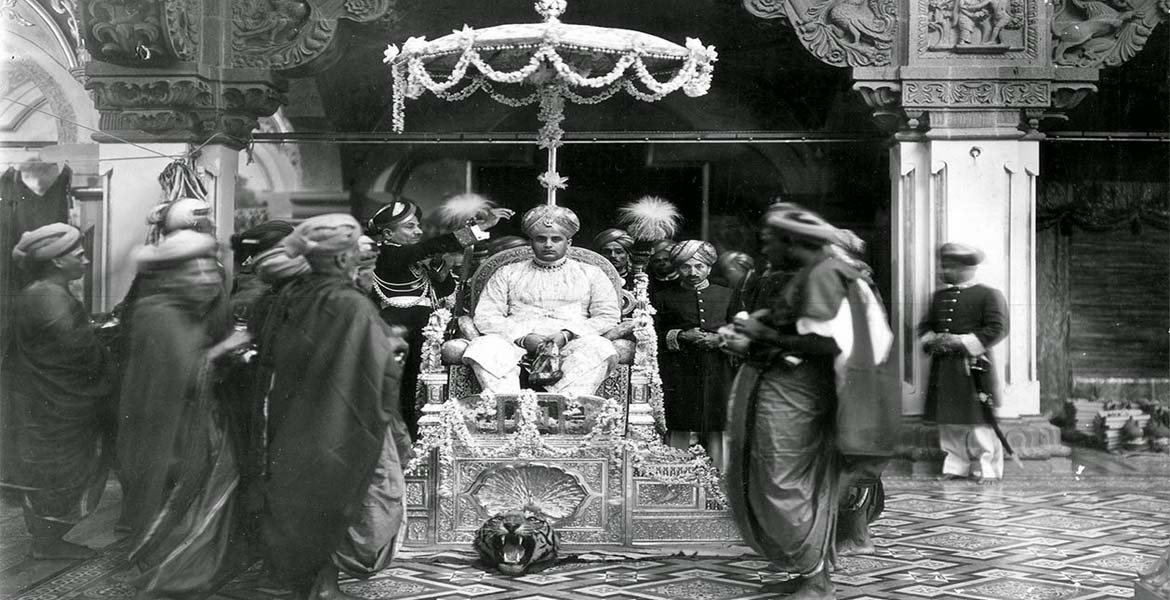
It can be rightly said that the golden throne emerges not only as apiece of artifact but as a residing chronicle of the city’s grandeur and its cultural heritage. What weighs over 280 kg and has more than 800 years of history, this regal masterpiece has become of center of attraction for Mysore. Sacred rituals like Ganpati Homa, Chamundeshwari Puja, Navagraha Homa etc adds a spiritual ring to the occasion. These traditions are being handed down through generations which breathes life into the golden throne. And this makes it more than a story of historical importance. It reverberates as a beacon of culture, a testament to artistic genius and a symbol of imperial strength. The throne serves as a living legacy and as a reminder that Mysore’s cultural pride is not just limited to its illustrious past but one that combines the thread of history seamlessly with the present. The recent arrival of the private court reveals not only a piece of art but a vibrant chapter in the ongoing story of Mysore. It is a story of a city where tradition, art and heritage combines to form an narrative that resonates over time.


